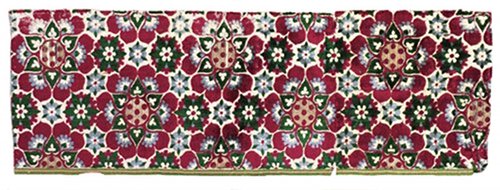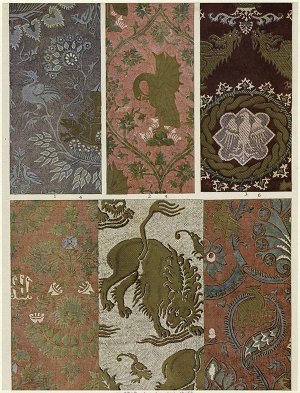Textiles
Explain how Europe benefited from cultural diffusion during the period c. A.D. 1000 - 1500.

Velvet Fragments with Medici Arms: Florence or Venice, c. 1440 - 1500.
Velvet
Velvet is a type of tufted fabric in which the cut threads are very evenly distributed, with a short dense pile, giving it a distinct feel.
Velvet can be made from many different kinds of fibers. It is woven on a special loom that weaves two pieces of velvet at the same time. The two pieces are then cut apart and the two lengths of fabric are wound on separate take-up rolls. Velvet was very expensive and was among the luxury goods.
Velvet is difficult to clean, but in modern times, dry cleaning is used. Velvet is made, ideally, from silk. Cotton can also be used, though this often results in a slightly less luxurious fabric.
The art of velvet-weaving probably originated in ancient Kashmir around the beginning of the 14th century. The earliest sources of European artistic velvets were Lucca, Genoa, Florence and Venice. Genoa continues to send out rich velvet textures. Somewhat later, the art was taken up by Flemish weavers, and in the 16th century Bruges attained a reputation for velvets which was not inferior to that of the great Italian cities.

Chocolate
brocade cloth
Brocade
Brocade is a class of richly decorative shuttle - woven fabrics, into which raised patterns have been woven.
They are often made in colored silks and with or without gold and silver threads.
The name, related to the same root as the word broccoli
comes from Italian broccato meaning embossed cloth,
originally from Latin broccus, projecting, pointed.
Ornamental features in brocade are emphasized and wrought as additions to the main fabric, sometimes stiffening it, though more frequently producing on its face the effect of low relief. In some, but not all, brocades, these additions present a distinctive appearance on the back of the material where the supplementary weft or floating threads of the brocaded or broached parts hang in loose groups or are clipped away.

Italian Silk Damask c. 1300s
Damask
Damask is a figured fabric of silk, wool, linen, cotton, or synthetic fibers, with a pattern formed by weaving. Made with one warp and one weft in which, generally, warp-satin and weft sateen weaves interchange. Twill or other binding weaves may sometimes be introduced.
The term originally referred to ornamental silk fabrics, which were elaborately woven in colors, sometimes with the addition of gold and other metallic threads. Damask weaves are commonly produced today in silk, linen or linen-type fabrics which feature woven patterns featuring flowers, fruit, forms of animal life, and other types of ornament.
Damask was first produced in China, India, Persia, and Syria, then the Byzantine Empire followed. In the West, it was first known as diaspron or diaper, the term used in Constantinople. In the 12th century however, the city of Damascus, famous for its textiles, so far outstripped all other places for beauty of design that it gave the cloth its modern name.
